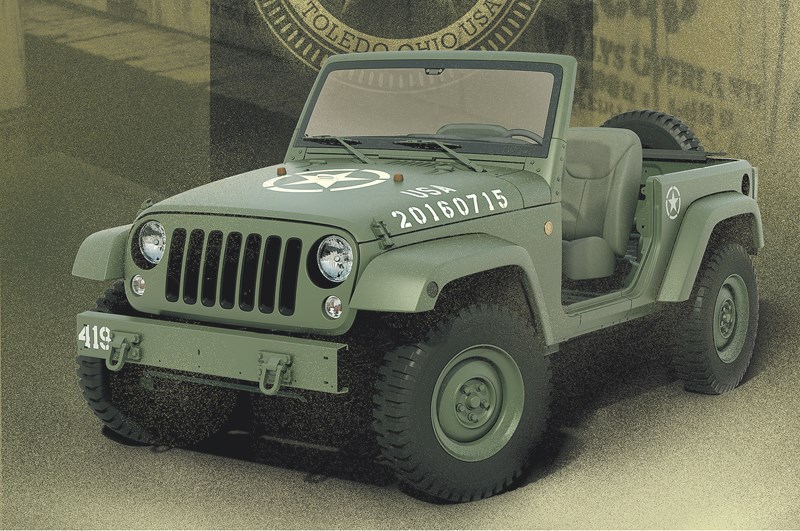Built as a tribute to the original, Fiat-Chrysler’s Jeep Wrangler 75th Salute is mean, lean, and very green. Standing in stark contrast to something like a leather-lined Grand Cherokee, the Salute comes with the Jeep’s base 3.6-litre V-6 engine, a six-speed manual transmission, and 16-inch wheels with 32-inch tires.
Doors?
Nope.
A roof?
Sorry, corporal.
How about satellite navigation?
Pipe down in the ranks there! You’ll go wherever General Patton says you’ll go, up to and including storming the gates of hell.
Painted olive-drab and lettered with military insignia, the Salute is exactly the same kind of Jeep you likely got with your plastic bag of little green army men, way back when. Sadly, a mounted .50cal is not an available option. And we may not even get a production model, as this machine is a concept only.
More than 75 years ago, two companies rallied to the United States Army’s request for a light reconnaissance vehicle. The Bantam car company and Willys-Overland were the only two of more than 130 companies contacted for bids. The army’s 49-day deadline looked impossible from the outside, and their demands were steep.
The original specs called for a four-wheel-drive vehicle with a wheelbase of only 80 inches, a total weight of 1,300 pounds, 85 foot-pounds of torque, a payload of 600 pounds, and a minimum ground clearance of six-and-a-quarter inches. The curb weight allowance was later raised to 2,160 pounds, but the challenge was still pretty steep.
Bantam hired Karl Probst, a sort of freelance engineer who had worked in various offices in Detroit. Their pitch was patriotism: initially, Probst worked without salary.
Apparently, if you’re not getting paid by the hour, you work fast. It took Probst just two days to sketch out full plans for the machine. Called the Bantam Reconnaissance Car, a hand-built prototype was sent to the army for testing in September of 1940. It passed with flying colours, missing only the torque requirements: the BRC made 83 foot-pounds.
Trouble was, Bantam as a company was far too small and shaky to supply the needs of a country that was about to engage in war on two fronts.
The army took the Bantam design to both Willys and Ford, and asked them to submit their own changes and updates.
From this strange three-sided development process, one single, recognizable Jeep emerged. From the Ford Pygmy, we got the familiar seven-bar Jeep grille. From the Willys Quad, we got the 2.2-litre “Go Devil” engine that would power nearly every original Jeep made. It produced 55 horsepower and 105 foot-pounds of torque, a fifth more than the army requirements. This final design would be the one that officially went into production in 1941, making the Jeep brand 75 years old this year.
Pygmy, Quad, BRC – so where does Jeep come in? Funnily enough, there’s no clear etymology to the name.
The best guess anyone has is a contraction of GP for General Purpose, the name the army gave its plucky little vehicle. There was also “Eugene the Jeep,” a character from a Popeye comic strip.
Wherever the Jeep name came from, it grew out of slang used by the soldiers who were driving them. They went everywhere and anywhere they were needed, both in the Pacific and European theatres, grinding through the mud and trudging up beaches.
They laid down communications lines, carried stretchers, towed light artillery.
Basically, the original Jeep was a sort of combat-ready donkey.
Even before the war ended, Willys-Overland realized that the tough, plucky little Jeep would work just as well as a plowshare as it would as a sword. The first civilian version was called the CJ-2A, and was built in 1945. It had bigger headlights, a tailgate, and a side-mounted spare tire, along with a host of small improvements to make it a little easier to live with day-to-day.
After several developments, the CJ-5 version of the Jeep was introduced in 1955.
There were versions before and after the CJ-5, but its production run was an incredible 29 years, lasting until 1984. The longer CJ-7, introduced during America’s bicentennial, overlapped production of the CJ-5 and eventually outcompeted it. And then, in 1987, we got the Wrangler, also known in Jeep circles as the YJ.
A Wrangler is what you can buy today, if you’re looking for a quote-unquote real Jeep. Despite three-quarters of a century of refinement, the bones are still there. A modern Wrangler is much larger than its basic little ancestor – especially if you opt for the four-door version – but the similarities are clear.
With the Land Rover Defender now defunct, the Wrangler represents a kind of vehicle you simply don’t find on the roads any more. The Jeep brand offers SUVs and Crossovers, but they are as defined by the original Jeep in the same way Mazda is defined by the Miata. You can buy vehicles with more stuff in them, but pare all the layers back, and you get to a simple ideal.
The hope is, with emission requirements growing ever more stringent, that the Wrangler’s simple, honest construction can continue to find enough fans that Jeep doesn’t have to civilize it entirely.
As the Wrangler Salute proves, all the creature comforts in the world are wonderful, but sometimes you just want to drive something that doesn’t even have any doors.
[email protected]



